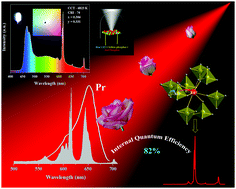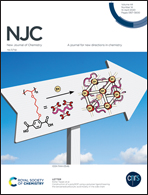High performance red/deep-red emitting phosphors for white LEDs†
Abstract
Highly efficient oxide-based red line emitters are still a bottleneck for smart white LEDs. In the present investigation, sequences of narrow band red emitting phosphors were synthesized via the conventional solid-state technique. The X-ray diffraction studies revealed that the as-synthesized phosphors were crystallized in the trigonal phase with the space group I41/a (88). Under 395 nm excitation, NaSrGd(MoO4)3:Eu3+ phosphors showed sharp red emission at about 616 nm because of the 5D0 → 7F2 transition (ED transition). Moreover, the internal quantum efficiency (IQE) was found to be 82%, and the thermal stability study showed that the NaSrGd0.5Eu0.5(MoO4)3 phosphor retains the emission intensity of about 71.5% of its initial room temperature intensity at 423 K. The red LEDs were designed for the NaSrGd0.5Eu0.5(MoO4)3 red phosphors with the NUV LED chip. White LED was also fabricated by conjugating the blue LED with yellow dye + red phosphor and the LED showed CCT (6823 K), CRI (74%), and CIE (0.306, 0.331). The Sm3+ and Eu3+ co-doped deep red phosphor was synthesized and studied in plant growth. The LED emission of Sm3+ and Eu3+ co-doped phosphor completely covers the absorption spectrum of Phytochrome Pr. All of these consequences revealed that the as-synthesized phosphor could be an efficient red emitting phosphor for warm white LEDs with application in plant growth research.



 Please wait while we load your content...
Please wait while we load your content...